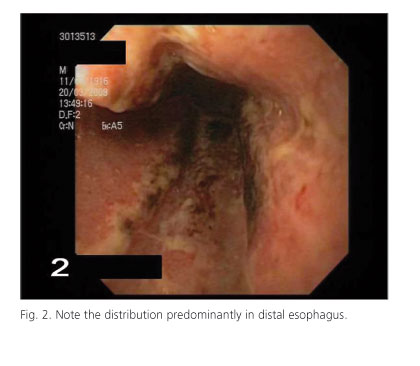Mi SciELO
Servicios Personalizados
Revista
Articulo
Indicadores
-
 Citado por SciELO
Citado por SciELO -
 Accesos
Accesos
Links relacionados
-
 Citado por Google
Citado por Google -
 Similares en
SciELO
Similares en
SciELO -
 Similares en Google
Similares en Google
Compartir
Revista Española de Enfermedades Digestivas
versión impresa ISSN 1130-0108
Rev. esp. enferm. dig. vol.103 no.8 Madrid ago. 2011
https://dx.doi.org/10.4321/S1130-01082011000800012
LETTERS TO THE EDITOR
Acute necrotizing esophagitis in a patient with femur fracture
Esofagitis aguda necrosante en paciente con fractura de fémur
Key words: Black esophagus. Necrotizing. Esophagitis. Fracture. Hypdrension. Aged.
Palabras clave: Black esophagus. Necrosante. Esofagitis. Fractura. Hipotensión. Vejez.
Dear Editor,
Acute necrotizing esophagitis, also known as "black esophagus", represents an infrequent and rarely suspected clinical entity. However, a growing number of cases have been reported worldwide since it was first described in 1990. This condition develops associated with severe concomitant diseases and it is believed to be related to a transient poor esophageal perfusion. On endoscopy, it consists of typical blackish esophageal lesions with exudates similar to those found in severe caustic esophagitis, originating its name (black esophagus). We present a case of this entity in an aged patient with femur fracture and hemodynamically unstable situation.
Case report
A ninety four year-old male patient with chronic atrial fibrilation, was admitted to the Emergency Department of our hospital for a femur fracture. During his stay at this service, the patient suffered several hypotension episodes, some of them accompanied by chest pain compatible with angor pectoris. After 15 hours of evolution, he presented with coffee ground vomits and underwent an emergency upper endoscopy which demonstrated the characteristic findings of the discussed condition, without any other acute endoscopic disorder (Figs. 1 and 2).
Discussion
Acute necrotizing esophagitis is probably an infrequent pathology. It was described for the first time by Goldenberg in 1990 (1). Since then, some short series have been published, showing a 0.01 to 0.5% incidence for all upper endoscopies, although necropsies have demonstrated a higher frequency (near 10%). It presents more frequently in males. Even though the ultimate causes remain unknown, it is supposed to be associated with esophageal ischemia, and therefore, it can be found in patients in poor general situation secondary to other concomitant illnesses. Thus, it has been related to ischemia, infections, anti-cardiolipine syndrome, massive reflux, hypothermia, renal failure, cancer and others (3-7). The biopsies will therefore show mucous and submucous necrosis (which appears brown-pigmented), smooth muscle involvement, and sometimes thrombosis of the esophagic vessels.
Upper gastrointestinal tract bleeding, especially as hematemesis or coffee ground vomits, is the most frequent presentation form in published reports. Endoscopy shows blackish esophageal lesions similar to those in caustic esophagitis. They tipically do not affect the gastroesophageal junction. Biopsies are not strictly necessary for the diagnosis, but they are helpful in the differential diagnosis with melanosis, pseudomelanosis, acantosis nigricans and melanoma.
Mortality is high (more than 30%), but it is mainly related to the severe associated condition more than to the esophagitis itself, as the esophageal lesions usually resolve independently of the severity of the underlying disease.
Carlos Fernández-Carrillo, César Barrios-Peinado and Fernando Pons-Renedo
Department of Gastroenterology and Hepatology. Hospital with Universitario Puerta de Hierro. Majadahonda, Madrid. Spain
References
1. Goldenberg S, Wain S, Marignani P. Acute necrotizing esophagitis. Gastroenterology 1990;2:493-6. [ Links ]
2. Jacobsen NO, Christiansen J, Kruse A. Incidence of oesophageal necrosis in an autopsy material. APMIS 2003;111:591-4. [ Links ]
3. McManus JP, Webb JN. A yeast-like infection of the esophagus caused by Lactobacillus acidophilus. Gastroenterology 1975;68(3):583-6. [ Links ]
4. Cappell MS. Esophageal necrosis and perforation associated with the anticardiolipin antibody syndrome. Am J Gastroenterol 1994;89(8): 1241-5. [ Links ]
5. Reichart M, Busch OR, Bruno MJ, Van Lanschot JJ. Black esophagus: a view in the dark. Dis Esophagus 2000;13(4):311-3. [ Links ]
6. Brennan JL. Case of extensive necrosis of the oesophageal mucosa following hypothermia. J Clin Pathol 1967;20(4):581-4. [ Links ]
7. Grudell AB, Mueller PS, Viggiano TR. Black esophagus: report of six cases and review of the literature, 1963-2003. Dis Esophagus 2006;19 (2):105-10. [ Links ]
















